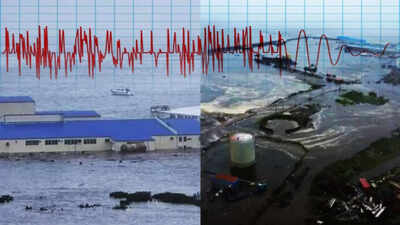ARTICLE AD BOX

Today, July 30, 2025 a powerful undersea earthquake near the Kuril Islands off the Russian coast triggered tsunami alerts across the Pacific, placing regions such as Hawaii and coastal California on high alert.
While no widespread damage was reported, the incident served as a sharp reminder of how the earth's quietest regions can rapidly become epicenters of destruction.Tsunamis are often misunderstood as isolated waves or weather events. In reality, they are complex natural phenomena with seismic roots, frequently linked to tectonic instability in vulnerable coastal zones. Their unpredictable nature, paired with the sheer speed and force with which they travel, is what makes them among the deadliest of natural disasters.
What is a tsunami?
A tsunami is a series of large ocean waves generated by a sudden displacement of water. This displacement is usually caused by undersea earthquakes, but can also be triggered by volcanic eruptions, landslides, or even glacial collapses. When the ocean floor abruptly shifts, it displaces a large volume of water, creating waves that move at speeds of up to 800 kilometres per hour in deep water. These waves grow in height as they approach shallower coastal areas, often striking with little to no warning.
Contrary to cinematic portrayals, tsunamis do not resemble typical surf waves. Instead, they arrive as rapidly rising walls of water, often preceded by an abnormal retreat of the shoreline, which can expose the seafloor before the waves strike.Over the last two decades, several tsunamis have demonstrated how devastating this natural force can be. Below are five of the most catastrophic tsunamis of the 21st century, ranked not only by death toll but also by their lasting geopolitical and humanitarian consequences.
Indian Ocean Tsunami (2004)
Date: December 26, 2004Magnitude: 9.1–9.3Death toll: Over 230,000Countries affected: Indonesia, India, Sri Lanka, Thailand, and moreTriggered by a massive undersea earthquake off the west coast of Sumatra, this tsunami remains the deadliest in recorded history. The waves, some over 30 metres high, radiated across the Indian Ocean, devastating coastal communities and killing hundreds of thousands within hours.
The lack of early warning systems in the region exposed severe gaps in disaster preparedness, prompting global reforms in seismic monitoring and humanitarian coordination.
Japan Tōhoku Tsunami (2011)
Date: March 11, 2011Magnitude: 9.0Death toll: Around 18,500Primary impact: Fukushima Daiichi nuclear disasterThe tsunami that followed the undersea quake off Japan’s northeastern coast was one of the most technologically and economically consequential disasters in modern history.
It inundated entire towns, triggered the meltdown of three nuclear reactors, and caused long-term displacement in Fukushima Prefecture. Japan’s preparedness and engineering resilience were notable, but even they were overwhelmed by the sheer scale of the catastrophe.
Sulawesi, Indonesia Tsunami (2018)
Date: September 28, 2018Magnitude: 7.5Death toll: Over 4,300Following an earthquake that struck the island of Sulawesi, the city of Palu was hit by a tsunami that destroyed thousands of buildings and claimed thousands of lives.
Poor coastal infrastructure, limited evacuation protocols, and delayed warnings contributed to the disaster. The event also included soil liquefaction, which led to entire neighbourhoods sinking or shifting dramatically.
Mentawai Islands Tsunami (2010)
Date: October 25, 2010Magnitude: 7.7Death toll: Around 500Region: Off the coast of Sumatra, IndonesiaA relatively underreported event, the Mentawai tsunami struck several remote Indonesian islands late at night, cutting off communities from rescue services for days.
The geographical isolation compounded the humanitarian crisis. Although the death toll was lower than other events, its severity was felt deeply in the affected islands, and it underscored the need for better outreach and emergency access in remote coastal areas.
Anak Krakatau Tsunami (2018)
Date: December 22, 2018Cause: Volcanic eruption-triggered landslideDeath toll: Over 430Region: Sunda Strait, IndonesiaUnlike typical tsunamis triggered by earthquakes, this disaster followed the collapse of a portion of the Anak Krakatau volcano into the sea, generating waves that struck without seismic warning.
Tourists and residents along the Sunda Strait coastlines were caught off guard. The event illustrated how diverse the causes of tsunamis can be, and why monitoring volcanic activity is as crucial as seismic zones.
Looking forward: Preparedness over panic
The recent earthquake near Russia's Kuril Islands and subsequent tsunami alerts in Hawaii and California may not have resulted in major damage, but they serve as a valuable reminder. Coastal regions, even those with advanced monitoring systems, remain vulnerable to undersea disruptions. The United States Geological Survey (USGS) and the Pacific Tsunami Warning Center continue to emphasise the importance of early warning infrastructure and public awareness.For students, educators, and community leaders, understanding the science behind tsunamis is just the starting point. What follows is preparedness — through drills, coastal planning, and cross-border cooperation. As climate and tectonic patterns evolve, staying informed becomes not just smart, but essential.TOI Education is on WhatsApp now. Follow us here.



.png)
.png)
.png)
















 21 hours ago
5
21 hours ago
5








 English (US) ·
English (US) ·